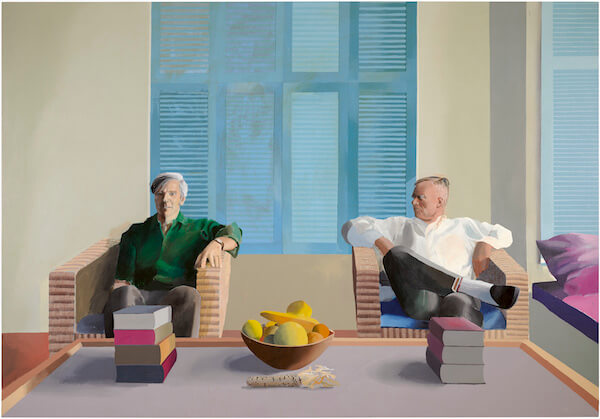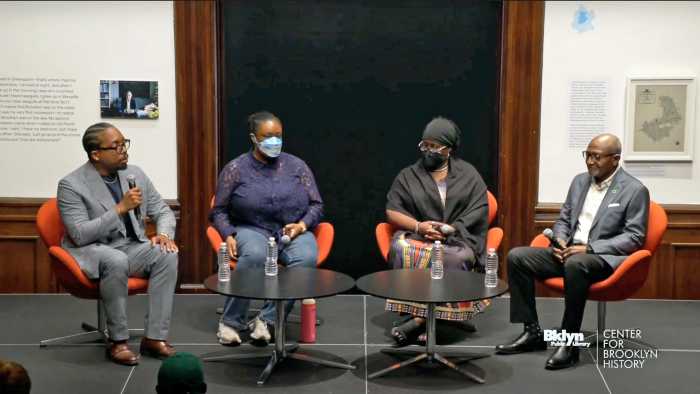Michelangelo’s “Three Labours of Hercules,” 1530–33
; drawing, red chalk; 10 11/16 in. x 16 5/8 in. | ROYAL COLLECTION TRUST / © HER MAJESTY QUEEN ELIZABETH II 2017, WWW.ROYALCOLLECTION.ORG.UK
Tommaso dei Cavalieri (1509-87) may not be a name as familiar as Michelangelo but he is integral to the utter fascination exerted by the truly blockbuster show “Michelangelo: Divine Draftsman and Designer,” which just opened at the Metropolitan Museum of Art.
Its brilliant curator, Dr. Carmen C. Bambach, has thankfully not stinted on the homosexual aspects of the great artist’s life and for the first time has brought together in one room the exquisitely rendered and quite homoerotic drawings Michelangelo gave to dei Cavalieri, for he was the love of his life.
Met’s painstaking show contextualizes his work, honors his passion for Tommaso dei Cavalieri
Dei Cavalieri was a 23-year-old Italian aristocrat when he was brought to Michelangelo’s house in Rome by their mutual friend, sculptor Pier Antonio Cecchini. The 57-year-old artist was immediately besotted by this beautiful youth who was also well-educated, highly intelligent, and cultured. They became lifelong friends, with dei Cavalieri present at his death bed, and, besides the drawings, Michelangelo dedicated approximately 30 poems to him, some 50 years before those gay sonnets of Shakespeare.
One of them read:
Love takes me captive; beauty binds my soul;
Pity and mercy with their gentle eyes
Wake in my heart a hope that cannot cheat.
During the 32 years they knew each other, they spent a lot of time together, but Michelangelo, who gave his heart and soul freely here, was often tortured by the younger man, who did not always reciprocate in kind. Their relationship became centered around the arts, with Michelangelo in mentor mode, engendering a constant stream of passionate correspondence between them.
Michelangelo’s “Cartoon with a Group of Soldiers for the Crucifixion of Saint Peter,” 1542–46
; drawing, black chalk and charcoal; 8 ft. 7 9/16 in. × 61 7/16 in. | MUSEO NAZIONALE DI CAPODIMONTE, NAPLES
The care and comprehensiveness bestowed upon this display of their relationship runs through this entire magnificent exhibit, which gives you real insight into this tirelessly energetic, complex, passionate, and ambitious man. Most fascinatingly, through the canniest selection and arrangement, Michelangelo’s actual working process is revealed, providing the rarest insight into the mind of a genius from 500 years ago. After eight years of intensive labor, Bambach has amassed 133 drawings and three sculptures, as well as a number of relevant sketches and paintings by contemporaries of Michelangelo, which beautifully contextualize the overall exhibition.
His work as an incredible architect is also represented, with gorgeous blueprints and one of the only three existing physical models he made, of a church dome. Bambach shares my asonishment that so many rare, priceless works were donated for the show from the most bewilderingly far-flung variety of museums, churches, and collections.
Bambach, whose book bearing the same title as this show accompanies the exhibit, obviously adores her subject, and her generosity was such that, even as the press preview at the Met was winding down, she led a small group of journalists through a private tour of the show that lasted two hours after the scheduled noon conclusion. (She had to finally be dragged by Met press officer Mary Flanagan to her overdue lunch.) Bambach was the perfect guide — impassioned, not pedantic, and completely accessible. I will forever treasure not only this show, but the experience of her guiding me through it, as every word out of her mouth was deeply enlightening.
Michelangelo’s “Studies for the Libyan Sibyl,” ca. 1510–11
; red chalk, with small accents of white chalk on the left shoulder; 11 3/8 in. x 8 7/16 in. | THE METROPOLITAN MUSEUM OF ART/ PURCHASE, JOSEPH PULITZER BEQUEST
She stopped at a thrillingly arranged trio of sculptured busts, led by Michelangelo’s Brutus, and said, “His whole world comes to life with research! Here, we see Michelangelo breaking new ground with a new kind of bust, with its contrapunto [turn of the head], more austere with less decoration than these contrasting older Roman ones, with their very complex, antique style. I was really keen to bring these ancient Roman busts to show his inspiration — the way the fabric gathers at the shoulder of this [other bust of] Julius Caesar and is caught by a clasp — and subsequent innovation. This one from Caracalla, I learned, belonged to a collector who lived right down the street from Michelangelo, before 1556. So, here we have not only the visual interest, but the fact that he probably visited the collector several times, and when the Museo Archeologico Nazionale in Naples said yes, they would loan it, I nearly fell to the ground! It’s important to widen the circle and look at some of Michelangelo’s collaborators, which puts the artist in a very different light through his contacts and the specific manner in which he collaborated with other artists.”
Bambach learned that one of the bust’s sculptors, Andrea Ferrucci, was the foreman of Michelangelo’s workers and marble sculptors in the creation of the New Sacristy in San Lorenzo.
Michelangelo’s “Young Archer, ca. 1490, marble overall, 37 in. x 13 ¼ in. x 14 in., 177 lbs. | THE METROPOLITAN MUSEUM OF ART/ LENT BY THE FRENCH STATE, MINISTRY OF FOREIGN AND EUROPEAN AFFAIRS
“All the loans were negotiated in person, and in some cases I had to go back many times,” she continued. “The Ashmolean Museum [in Oxford, England] was an especially wonderful friend from the beginning, in a way a sister to this museum, lending 26 drawings, around which we could build this exhibit.”
The show climaxes with Michelangelo’s glorious achievement, his “Last Judgement of the Sistine Chapel,” about which Bambach explained, “I can’t tell you how touched I was when the Museo e gallerie nazionali di Capodimonte lent us the two huge cartoons and the large painting of the ‘Last Judgment’ by Marcello Venusti, which is so beautiful and very fragile. It was made with Michelangelo’s supervision and depicts the figures in ‘The Last Judgment’ before the loincloths which [Daniele] da Volterra painted over them in 1565, [which were] removed in the 1980-94 restoration of the Sistine.”
One of the cartoons, with its loving and very obvious focus on the posteriors of a group of men, reveals Michelangelo as a definite “ass man.”
Bambach made the shocking event of the fresco’s unveiling come alive as she led us to a print depicting the layout of the Sistine Chapel at that time.
“Here we begin to see why this would be very scandalous,’ she explained. “You see the pope at the altar, officiating Mass, the cardinals, and then the noblemen, a deeply ceremonial place. Now, imagine having all those naked people on the altar wall! What is absolutely fascinating is the extent to which Popes Clement VII and Paul III allowed Michelangelo to have this extraordinary creative freedom, because they wanted him to portray what he wanted to, as long as it was a last judgement and resurrection of the dead. But many of the succeeding popes did not feel this way and [besides the censoring loincloths] there were threats to pull it down.
Michelangelo’s “Archers Shooting at a Herm, 1530–33; drawing, red chalk; 8 5/8 in. x 12 11/16 in. | ROYAL COLLECTION TRUST / © HER MAJESTY QUEEN ELIZABETH II 2017, WWW.ROYALCOLLECTION.ORG.UK
“Much of the controversy and public accusations of indecency were fueled by the published letters of [poet] Pietro Aretino [who accused the artist of turning the Sistine into his whorehouse with those naked figures]. They came out of his frustration that he was unable to get a single drawing from Michelangelo, although many of them had been consigned to the fire. In several letters to him, he grovels but the artist doesn’t even deign to answer. It’s interesting to think about these things and the insatiable desire even back then to own something made by Michelangelo. Aretino was an incredible art collector, and it would have given him prestige to own a Michelangelo, who was by then a huge celebrity. There were concerns about his health and this was extraordinary, as it was not common then. Of course, we have all of this in the art world today, but this was unheard of, so this was the beginning of all that.”
MICHELANGELO: DIVINE DRAFTSMAN & DESIGNER | Metropolitan Museum of Art, 1000 Fifth Ave. at E. 82nd St. | Through Feb. 12: Sun.-Thu., 10 a.m.-5:30 p.m.; Fri.-Sat., 10 a.m.-9 p.m. | $25; $17 for seniors; $12 for students at metmuseum.org/exhibitions/listings/2017/michelangelo







































